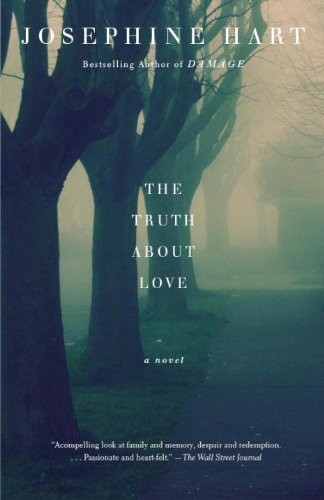
The Truth About Love
کتاب های مرتبط
- اطلاعات
- نقد و بررسی
- دیدگاه کاربران
نقد و بررسی

June 29, 2009
Hart's previous five novels (Damage
; Sin
) addressed the disturbing power of love, and in her latest, she returns to the topic with mixed success. Hart opens with the stream-of-consciousness narration of a teenage boy's fatal accident in 1962 Ireland before shifting to the precise, nearly stifling voice of Thomas Middlehoff (aka “The German”) at the funeral. Distant and polite, Thomas orbits ever closer to the beleaguered O'Hara family: the boy's father, Tom, wants to buy a family heirloom from Thomas; he bumps into Olivia, the boy's sister, with his car (she sustains scrapes and bruises); and the boy's mother, Sissy, exposes her deep grief to him, spurring him into contemplations of his own secrets and horrors. After another Joycean interlude depicting Sissy's treatment in a mental hospital, Olivia takes over the story from the present day, and though outwardly successful, she refuses to let go of her anger at her brother's death. Unfortunately, revelations in the second half of this brief novel feel rushed, while the characters' proclivities for introspection do little to create narrative urgency.

July 1, 2009
An Irish boy's death continues to haunt his family circle for 40 years in Hart's elliptical, chimerical tale.
Like most of their compatriots in a country torn by dissension and shrunken by emigration, Tom and Sissy O'Hara have never had an easy time of it. But nothing in their lives has prepared them for the way their world shivers and contracts on the June day in 1962 when their son is killed in an accident. From that moment on, the couple's principal business is survival. It's a job they share with their daughter Olivia—second son Daragh is no more than a wraithlike walk-on—and, curiously, with Thomas Middlehoff, a German neighbor who's settled in Leinster to retreat from his homeland and write on literary subjects. Beginning with Middlehoff, Hart (The Reconstructionist, 2001, etc.) presents narratives from his point of view, Olivia's and Sissy's. Despite Tom O'Hara's heart-rending devotion to his wife, she sinks so deep in despondency that she's eventually hospitalized, splintering her family and provoking Olivia's resentment. Middlehoff, a sober widower of surprisingly delicate sensibility who clings to his own mistress as if to a life raft, is drawn closer to the family when Tom asks if he can buy an ornamental gate his son had admired. But it's Olivia's perspective that's the most surprising. Years after her mother returns home, having"slipped behind the event and gone back to who she was before," Olivia, now a highly regarded actress ("I stumbled into acting. It happens"), spins a skein of reminiscences that increasingly drift toward a chronicle of Ireland's purgatorial generation of bombings, crackdowns, hunger strikes and tentative accords, blurring the line between her fierce, undying love for her brother and her equally troubled love for her country.
Focusing on the overwhelming question Olivia asks her Harley Street therapist—"What's wrong with loving someone for life? Even when they are dead?"—Hart produces her least mannered, most moving novel to date.
(COPYRIGHT (2009) KIRKUS REVIEWS/NIELSEN BUSINESS MEDIA, INC. ALL RIGHTS RESERVED.)

Starred review from August 15, 2009
Hart's affecting new work opens with the extraordinary monologdesperate and fragmentedof a teenaged boy who's just been blown apart in an explosion he has innocently engineered. "Turn me over quickly. Don't let my mother see me," he thinks. That's one sign of love. Another sign is how devotedly husband and daughter watch over the mother after the boy dies, the daughter even engaging in some fiercely well-meant tough talk when the mother is hospitalized, unable to bear the loss of her son after the earlier death of a daughter. The husband even persuades Mr. Middlehoff, a German who lives in town, to part with a gate that seems a fitting memorial. And then the mother revives and goes on, this being stolid small-town Ireland in the early 1960s, where difficulties are meant to be survived. But as the daughter, Olivia, realizes, Ireland is changing, and Mr. Middlehoff is there to add a depth of understanding that others lack. VERDICT Poignant, engrossing, and deftly realized, this is a more nuanced read than the author's still excellent "Damage" and should be considered by most fiction readers.Barbara Hoffert, "Library Journal"
Copyright 2009 Library Journal, LLC Used with permission.

July 1, 2009
Just as various lights that are cast on an object reveal a variety of textures and contours, Hart sheds narrative illumination, via a series of interior monologues, on one particular event and its decades-long consequences. In a small town in 1960s Ireland, a teenage boy is killed in a dreadful accident. His sister, his mother, and a man who is a neighbor, each recalling her or his own life as permanently marked by the absolutely senseless death of the lad, paint in painful but hopeful brushstrokes their versions of the intertwining of love and loss and how the former makes the latter endurable. Structurally sound despite its abrupt shifts from one persons point of view to another and back again, this relatively short but decidedly jolting novel by the author of The Reconstructionist (2001) gives dramatic evidence that brevity can easily move hand in hand with potency.(Reprinted with permission of Booklist, copyright 2009, American Library Association.)

























دیدگاه کاربران